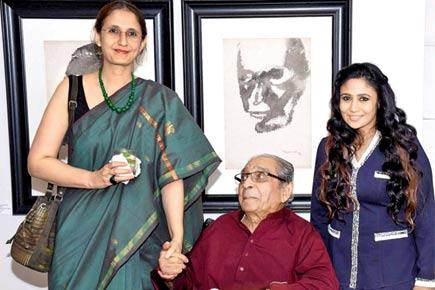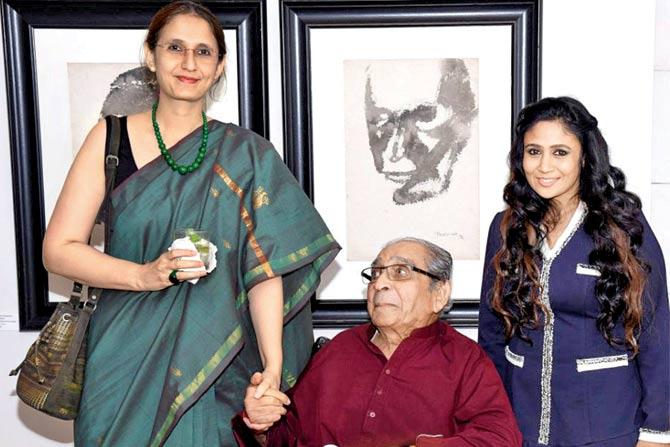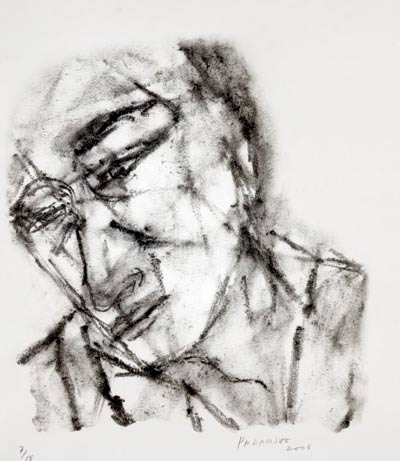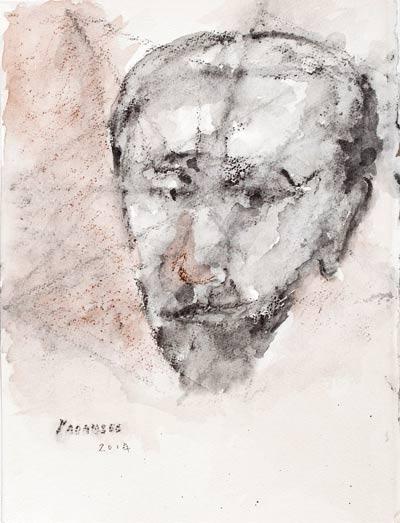In a new book, Nancy Adajania and Priyasri Patodia delve into the 'late style' of one of India's most important Modernist painters

Nancy Adajania, Akbar Padamsee and Priyasri Patodia PIC/ Priyasri Art Gallery
 In an upcoming book on artist Akbar Padamsee, cultural theorist and curator Nancy Adajania evokes a series of monochrome 'Heads' made in watercolour and water-soluble crayons. Rather than full forms, they expose their skeletal systems — a grid made of fine lines, like scaffolding — that Padamsee calls schema. The heads are exposed, but still hard to read. Adajania writes, "Are these faces at all?" one might ask. Are they not star maps, or a Biblical plague manifested as a swarm of locusts…?’ Padamsee’s response to her musings was, 'I am not drawing a man or a woman.'
In an upcoming book on artist Akbar Padamsee, cultural theorist and curator Nancy Adajania evokes a series of monochrome 'Heads' made in watercolour and water-soluble crayons. Rather than full forms, they expose their skeletal systems — a grid made of fine lines, like scaffolding — that Padamsee calls schema. The heads are exposed, but still hard to read. Adajania writes, "Are these faces at all?" one might ask. Are they not star maps, or a Biblical plague manifested as a swarm of locusts…?’ Padamsee’s response to her musings was, 'I am not drawing a man or a woman.'

Nancy Adajania, Akbar Padamsee and Priyasri Patodia PIC/ Priyasri Art Gallery
ADVERTISEMENT
Where the Lines Fall, with texts by gallerist and independent writer Priyasri Patodia and Adajania, features paperworks by one of the Modernist pioneers in the country. The book is an outcome of years of association between Padamsee and the authors, and, in his own words, "an archaeology of my mind". Booking for this publication, to be released in October and priced at R3,500, have already started, with collectors keen on acquiring the works as well.

Untitled (2010), lithograph
While Patodia and Adajania have focused on Padamsee’s paperworks made in the last two decades and his journey as a printmaker, the schema has also been of interest to them. “He is almost like a mathematician; he calculates the space he paints on regardless of the medium. In recent times, he has been inconspicuously or conspicuously leaving the schema lines which he would earlier erase as the works progressed,” says Patodia, who, after watching Padamsee work out of his Prabhadevi studio, thought that his schema were as magnificent as his complete works.

Untitled (2014), watercolour
The schema show Padamsee — the Modernist famed for his metascapes and mirror images — in a more intimate light. “When I asked Akbar: ‘Why printmaking?’ his response was that he simply likes to draw. He loves Picasso’s lithos and has experimented with acids and plates,” says Patodia.
Adajania says that by its very nature, a drawing allows for free play, which a painting, being more premised on composition, does not. But, it’s more than just immediacy that she is talking about. “I see Akbar’s drawings and prints of the last two decades as an articulation of what Edward Said calls a ‘late style’, which implies a liberation of the artist from the expectations that viewers have come to associate with his signature style,” she explains.
The Padamsee signature style is, however, one that viewers and the art market could have filtered from his experimental tendencies. In addition to his painted work, Padamsee made SYZYGY, a film which used a set of geometrical drawings, and Events in a Cloud Chamber, a colour-reversal film. Padamsee used the Nehru Fellowship, which he was granted in 1969, to design a workshop where interactions between various visual mediums could take place. The Vision Exchange in New Delhi and Mumbai became the platform for photographers, printmakers, filmmakers, architects and psychoanalysts to exchange notes outside their own disciplines. An etching press, a lithography press and a dark room for photography were among the Exchange’s offerings.
And, Padamsee’s love for printmaking, which began in the 1950s in Paris, only flourished when he conceived a programme for a project named xplaxis in 1990. Financed by Ajay Lakpal, a businessman from Delhi, Padamsee travelled to various centers and collected 120 prints of established and lesser-known printmakers.
In April this year, Patodia hosted Padamsee’s 87th birthday with an exhibition of 110 rare works on paper, many of which have been written about in Where the Lines Fall. Adajania says, “His ‘heads’ are falling through the void even as they are propped up by the faint lines of a scaffolding schema. Rather than achieving a settled style in the autumn of his life where all contradictions of life and art have been resolved, Akbar surprises us with a stubborn will to resist communication. We cannot simply wish this away as a conversation with death the great leveller. There seems to be a new conversation about survival, redemption and the will to form.”
While Patodia prepares for another exhibition, later this year, that will bring together Padamsee and his contemporaries Jogen Chowdhury and Krishen Khanna, she speaks of how the artist spends time reflecting on his works as much as he does making them. “He compares this process to an earthquake,” she says, “the way we investigate its causes once the calamity has hit us.”
 Subscribe today by clicking the link and stay updated with the latest news!" Click here!
Subscribe today by clicking the link and stay updated with the latest news!" Click here!







